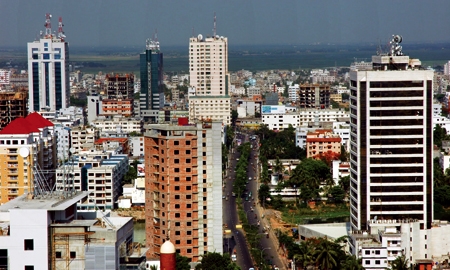The financial sector has come a long way in the four decades since Bangladesh gained its independence, growing steadily in line with the economy.
Forty years ago, when the country’s banks were almost entirely state-owned, their credit and investment assets totaled a mere $90 million or so. In today’s market-based sector, the amount is more than 650 times higher at $57 billion.
There are now many more banks – almost 50, including four state-owned lenders, four specialized development banks, and 10 foreign banks, including
Citibank, HSBC, and Standard Chartered – and licenses have been issued for nine new ones.
Decades of institutional and market reforms overseen by Bangladesh Bank, the country’s central bank, have resulted in a robust and stable financial system that weathered the financial storms of the East Asian currency crisis of the mid 1990s and the global financial crisis of 2008-09 with no need for bank bailouts.
The bank has overseen the introduction of global best practice standards for capital adequacy and liquidity. The 11% overall risk weighted capital base of Bangladesh’s banks is above the international Basel II regulatory requirement, while non-performing loans as percentage of total assets are at single digit levels, and liquidity stresses arising from unduly high advance deposit ratios in some banks last year have eased.
Stress test exercises have resulted in World Bank-IMF assessment of the financial sector as resilient against moderate shocks. Meanwhile preparations are under way for the implementation of Basel III requirements by the 2018 deadline or earlier.
There is no complacency at Bangladesh Bank, however, despite the reassuring overall view. Atiur Rahman, the Governor of the bank, says that as Bangladesh advances towards its goal of becoming a prospering advanced nation fully integrated with the global economy there is a need for further reform across every aspect of the bank supervisory system – from the IT architecture to liquidity risk monitoring.
He insists the central bank is committed to putting in place a regime of “macroprudential supervision” and making the most relevant tools and practices available as both the economy and the financial sector itself expand.
| Decades of institutional and market reforms overseen by the central bank have resulted in a robust and stable financial system |
“Much of our growth-related new investments will have to be attracted abroad, heightening our financial sector’s exposure and vulnerabilities to market volatilities in the global scene,” he says.
“In step with rising external exposures, our financial sector will need to build up and bolster resilience against shocks from perennial volatilities and instabilities of the international markets. Besides shocks of external origin, there are also the demand and supply shocks of domestic origin to build up resilience against, particularly as the market-based Taka interest and exchange rates may move in adverse directions.”
Mr. Rahman says the central bank intends to work further with other regulatory authorities towards faster upgrading of corporate governance and disclosure practices in the overall business environment, both in the financial and real sectors.
Strengthening Bangladesh Bank’s supervisory oversight will continue to remain a high priority, including specifically on risk management, corporate governance, internal control, and internal audit in banks.
Unusually, the central bank does not have full monitoring control over all the country’s lenders. A “dual governance” arrangement gives the Finance Ministry partial control over supervision of the state-run banks.
This can lead to a blurring of responsibility when things go wrong, as has been clearly demonstrated in the case of one of the country’s most recent and biggest ever banking scandals, a $43 million scam involving a state-owned bank and the little-known Hallmark Group.
Mr. Rahman wants full supervision powers to rest with the central bank. He says, “Exemption of state-owned banks from some of Bangladesh Bank’s supervisory empowerments of the Bank Companies Act stands in the way of effective supervision of these banks. Unless this differential treatment is done away with, management weaknesses from insufficient accountability are likely to linger in the state-owned banks.”
The International Monetary Fund agrees, and says the release of the $140 million second tranche of its $1 billion Extended Credit Facility to Bangladesh is contingent on the government amending the Bank Companies Act so that the state-run and specialized banks come within the full supervisory control of the central bank.
In terms of the economy generally, Mr. Rahman believes that amid the global slowdown Bangladesh’s macroeconomic trends are broadly on course towards attainment of its goal of becoming a middle income country.
According to the Economist Intelligence Unit between July 2011 and June 2012, Bangladesh enjoyed an estimated real GDP growth of 6.3%, a figure the EIU forecasts will be maintained over the coming five years.
While Bangladesh’s economy is supported mainly by services and industry, nearly half the population works in agriculture.
Abul Amaal Abdul Muhith, Minister of Finance, says that agriculture needs more attention, as does the issue of power generation. “I see the future of Bangladesh including large developments in the rural areas… because they are occupying most of our land. Along with agricultural development, we need to develop the power sector. About 50% of the electricity of our country is for rural areas. The problem is not power transmission, the problem is power generation,” he highlights.
Mr. Muhith adds that foreign investment in Bangladesh has been hindered in part due to power shortages, but that by increasing the use of coal (in addition to natural gas, a resource the country has plenty of), “I hope we will be able to correct our electricity crisis very soon,” he concludes.

0 COMMENTS